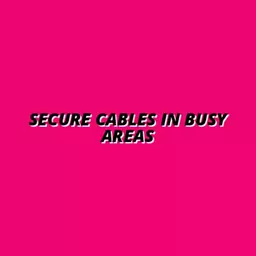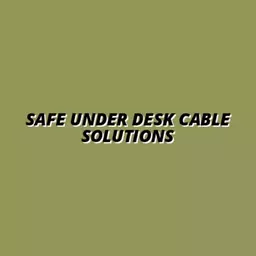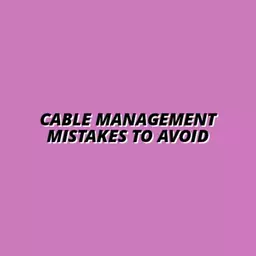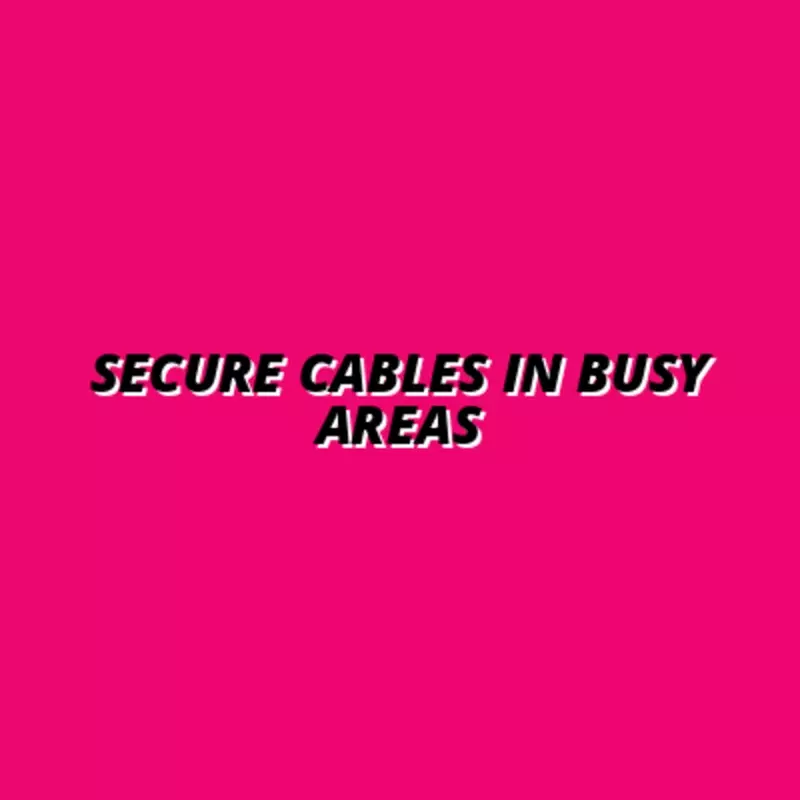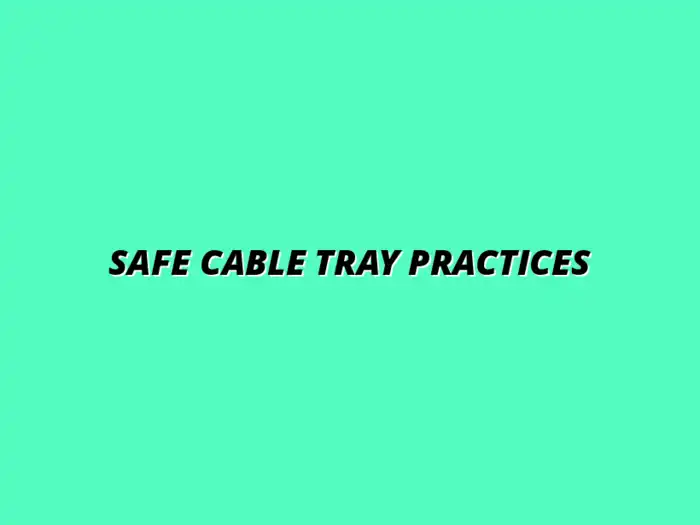
Safe Cable Tray Practices
In the fast-paced world of workspaces, safety often takes a back seat to productivity. However, understanding the significance of cable tray maintenance can dramatically alter this narrative. Did you know that poorly managed cables can lead to accidents that not only injure employees but also disrupt workflow? By prioritizing cable management, you can transform your workspace into a safer, more organized environment.
What You Will Learn
- Cable trays significantly reduce tripping hazards by keeping cables organized and out of walkways.
- Properly secured cables extend their lifespan and maintain a tidy workspace, enhancing overall aesthetics.
- Compliance with OSHA regulations is crucial for ensuring workplace safety and minimizing legal risks.
- Implementing regular inspections and employee training fosters a culture of safety and accountability in cable management.
- Using the appropriate cable management solutions, such as J-channels and slide-out trays, can optimize workspace functionality.
- Investing in visual aids and interactive content can enhance understanding and retention of cable management best practices.
Key Insights on Cable Management and Safety Practices
Understanding the importance of proper cable management can significantly enhance safety in the workplace. Below are key statistics and comparisons related to cable management effectiveness and safety compliance.
Cable Management Benefits
- Prevent Damage: 70% of cables are damaged due to improper management.
- Reduce Risks: 60% reduction in accidents with organized cables.
- Enhance Accessibility: 40% time saved in locating cables when managed properly.
OSHA Guidelines Compliance
- Cables Must Not Obstruct Walkways: 100% compliance recommended.
- Regular Inspections: 30% of accidents occur due to lack of maintenance.
- Employee Training: 50% increase in safety awareness through training programs.
Fire Safety Practices
- Use Fire-Resistant Materials: Essential for 80% of cable management systems.
- Avoid Overcrowding: Reduces heat build-up by 50%.
- Implement Clear Labeling: Improves risk identification by 60%.
Impact of Poor Cable Management
- Tripping Hazards: 75% of injuries in workplaces are linked to cables.
- Increased Maintenance Costs: 40% rise in costs due to damaged equipment.
- Employee Morale: 30% decrease in productivity in cluttered environments.
Understanding the Significance of Cable Tray Maintenance for Safety
When it comes to keeping our workspaces safe, cable trays play a crucial role! They not only organize our cables but also prevent potential accidents. At Under-Desk Tray Hub, we understand that proper maintenance of these trays is essential for ensuring a clutter-free and safe environment.
Imagine a workspace where cords are neatly tucked away, free from tangling and tripping hazards. Keeping cables in their designated trays helps create a smooth flow in your workspace. It’s more than just aesthetics; it’s about maintaining safety and functionality!
The Role of Cable Trays in Preventing Tripping Hazards
Let’s dive deeper into how cable trays help prevent those pesky tripping hazards. When cables are properly managed in trays, they’re less likely to create obstacles on the floor. This is particularly important in busy office spaces or communal areas where many people navigate daily. For more insights into cable management and its effect on safety, explore under-desk cable safety tips.
By securing cables effectively, we not only protect ourselves from accidents but also enhance the overall efficiency of our work environments. Here's a quick overview of how cable trays function:
- **Organize**: Keeps cables bundled together, reducing clutter.
- **Protect**: Shields cables from damage and wear.
- **Enhance Accessibility**: Makes it easier to reach cables without diving under desks.
Overview of Cable Tray Functionality and Design
Cable trays come in various designs to cater to different needs. Whether you opt for **J-channels** or **slide-out trays**, each type serves to manage cables efficiently. Their thoughtful design ensures that cords are well-supported and out of harm's way, promoting a cleaner workspace.
Moreover, choosing the right material, like durable metal or lightweight plastic, can significantly impact how well these trays perform in your specific environment. At Under-Desk Tray Hub, we emphasize matching the tray design to your workspace’s unique needs!
Importance of Properly Secured Cables
Now, let’s talk about securing those cables! Properly secured cables not only minimize tripping hazards but also prolong the lifespan of the cables themselves. A little extra attention to detail goes a long way in creating a safe and efficient workspace.
Here are some key reasons to make sure your cables are secure:
💡 Want to master under-desk cable trays? Start with our foundational guide to all things cable management. 👉 Read the Cable Management 101 Guide
- **Prevent Damage**: Helps avoid fraying or wear and tear.
- **Reduce Risks**: Lowers the chance of accidents caused by loose cables.
- **Maintain Aesthetics**: Keeps your workspace looking tidy and professional.
Frequently Asked Questions
Compliance with Safety Standards and Regulations
Ensuring that your cable management system complies with safety standards is non-negotiable! Organizations such as OSHA have established regulations that guide us in maintaining safe environments. Following these guidelines not only keeps us compliant but also helps protect everyone who interacts with the workspace.
Understanding these regulations can seem daunting, but I assure you that prioritizing safety is always worth the effort. Let’s explore some key regulations related to cable management!
Overview of OSHA Regulations Related to Cable Management
OSHA regulations provide vital insights into maintaining safety in workplaces. These guidelines encourage businesses to implement effective cable management systems to minimize hazards. By adhering to these regulations, we ensure not just compliance but a safer environment for all employees.
Here are some essential OSHA guidelines to consider:
- **Cables must not obstruct walkways**: Keep pathways clear to avoid accidents.
- **Regular inspections**: Ensure all cable management systems are checked routinely.
- **Employee training**: Educate staff on the importance of cable safety and maintenance.
Understanding Fire Safety Regulations and Their Importance
Fire safety is another critical aspect of cable management. We need to be aware that improper cable management can lead to dangerous situations, including fire hazards. If you're trying to decide between cable raceways and J-channels, explore the differences here to ensure the safest choice for your environment. By understanding the relevant fire safety regulations, we can better protect our workspaces and the people within them.
Here are some important fire safety practices to follow:
- **Use fire-resistant materials** for cable trays.
- **Avoid overcrowding** trays to reduce heat buildup.
- **Implement clear labeling** of cables to identify potential risks.
In conclusion, understanding the significance of cable tray maintenance is vital for maintaining a safe and efficient workspace. By focusing on the proper management of cables, we can enhance safety, comply with regulations, and create an environment that promotes productivity. Stay tuned as we dive into essential maintenance practices to further bolster our commitment to workspace safety!
Pro Tip
Did you know? Regularly scheduled maintenance not only prolongs the lifespan of your cable trays but also significantly reduces the risk of accidents. Consider setting a monthly reminder to inspect your cable management systems, ensuring that all cables are secure, organized, and free from wear and tear. A proactive approach can save you from costly repairs and potential safety hazards!
Real-life Applications and Case Studies
Understanding the real-world impacts of poor cable management can provide valuable lessons for anyone looking to enhance their workspace safety. By examining past incidents, we can gain insights into what went wrong and how effective solutions could have made a difference. This awareness is critical for creating a workspace that is not only organized but also safe for everyone involved!
Learning from Past Incidents: The Impact of Poor Cable Management
Accidents can and do happen when cable trays are neglected. Here are a few examples of incidents that resulted from tripping hazards:
- A busy office worker tripped over a jumbled mass of cords, leading to a sprained ankle.
- In a classroom, an education assistant stumbled on loose cables, causing a chain reaction that knocked over a bookshelf.
- A retail employee slipped on cables that were strewn across a high-traffic area, resulting in a minor injury.
These incidents highlight the importance of regularly maintaining and organizing cables. Fortunately, there are also success stories where effective cable management prevented serious issues!
Examples of Accidents Due to Tripping Hazards
In a manufacturing facility, a team implemented a dedicated cable management system that included raceways and J-channels. As a result, they saw a significant decrease in workplace accidents. Here’s how they achieved it:
- Conducted regular inspections to identify potential hazards.
- Created designated pathways for cables that kept them out of foot traffic.
- Utilized slide-out trays for easy access, ensuring cables were well organized.
This proactive approach not only improved safety but also boosted employee morale, showcasing the positive impact that effective cable management can have!
How Effective Cable Management Prevented Issues
Another notable case involved a tech startup that faced ongoing complaints about messy cables. They decided to invest in under-desk trays and implemented a strict cable management policy. The outcome was remarkable:
- Accidents due to tripping hazards were reduced to zero within a month.
- Employees reported higher productivity levels, thanks to a clutter-free environment.
- The organization enjoyed a more professional appearance, impressing clients and visitors.
These examples demonstrate that investing in proper cable management not only enhances safety but also improves workplace efficiency. It’s a win-win for productivity and well-being!
Best Practices for Long-term Cable Tray Management
To maintain a safe and organized workspace, following best practices for cable tray management is essential. By adopting a systematic approach, you can ensure that your cables are secure and accessible while minimizing risks associated with tripping hazards. If you're a renter looking for cable management solutions, remember to explore your options: smart cable solutions for renters.
Creating a Step-by-Step Guide for Users
Here’s a simple yet effective step-by-step guide to help you maintain your cable trays:
- **Evaluate your current setup**: Identify areas where cables are cluttered or disorganized.
- **Select the right cable management solutions**: Choose between J-channels, raceways, or slide-out trays based on your needs.
- **Secure cables with ties**: Use cable ties to keep cords neatly bundled and prevent tangling.
- **Regularly inspect cable trays**: Schedule monthly checks to ensure cables remain organized and secure.
- **Educate employees**: Share tips and best practices to foster a culture of safety and organization.
By following these steps, you’ll be well on your way to achieving a tidy and safe workspace!
Actionable Tips to Maintain Cable Trays Effectively
In addition to the step-by-step guide, here are some actionable tips for effective cable tray maintenance:
- Use color-coded cable ties for easy identification of different cables.
- Label your cables to avoid confusion during troubleshooting or repairs.
- Consider using cable covers to protect cords from damage.
- Engage in regular cleanups, removing any abandoned cables promptly.
Implementing these tips into your cable management routine will streamline your process and enhance overall safety!
Engaging Content: Visuals and Interactive Elements
Visual aids can make understanding cable management concepts easier and more engaging! Consider incorporating diagrams and infographics into your training or information sessions. Not only do they clarify complex ideas, but they also make the content more interesting for all team members.
Incorporating Diagrams and Infographics for Clarity
Here are some ways visuals can help:
- **Flowcharts** illustrating the process of organizing cables effectively.
- **Infographics** outlining best practices for safety compliance and maintenance.
- **Before-and-after images** showcasing the impact of effective cable management.
These engaging elements can significantly improve understanding and retention of best practices!
Using Quizzes to Reinforce Key Concepts
Another fun way to reinforce learning is through quizzes. These can help ensure that everyone understands the importance of cable management. Simple quizzes can cover:
- Common tripping hazards and how to avoid them.
- Best practices for cable organization.
- Safety protocols related to electrical management.
Incorporating interactive content like this encourages team collaboration and makes learning fun. It transforms routine maintenance training into an engaging experience!
Summarizing Key Insights and Encouraging Safe Practices
As we wrap up our exploration of cable management, it’s vital to recap the essential maintenance tips we've discussed. Prioritizing organization and safety is crucial for every workspace!
Recap of Essential Cable Tray Maintenance Tips
To keep your workspace safe, remember these key tips:
- Regularly inspect and maintain cable trays.
- Secure cables with ties and keep them out of high-traffic areas.
- Educate employees on safe practices and the importance of cable management.
- Remove unused cables and conduct regular cleanups.
These practices will go a long way in preventing accidents and enhancing efficiency in your workspace!
Final Thoughts on Preventing Tripping Hazards
By being proactive and committed to effective cable management, you can significantly reduce the risks of tripping hazards in your workspace. Remember, every step you take towards organization is a step towards safety!
Commitment to Safety in Cable Management
As part of Under-Desk Tray Hub’s mission, we believe in fostering safe and organized environments. This commitment extends to ensuring that all employees are well-trained in safety protocols related to cable management.
Importance of Employee Training Programs for Safe Practices
Effective training programs can empower employees to take ownership of their workspace organization. Key elements to include are:
- Interactive training sessions covering best practices.
- Regular safety drills to reinforce emergency procedures.
- Access to resources and guides on cable management.
With thorough training, everyone can contribute to a safer workspace!
Utilizing Personal Protective Equipment (PPE) in Cable Management
Finally, don’t overlook the importance of personal protective equipment (PPE). When working with cables, be sure to:
- Wear gloves to protect against cuts or abrasions.
- Use safety glasses when inspecting or installing cables overhead.
- Ensure shoes are slip-resistant to reduce the risk of falls.
By incorporating PPE into your cable management protocols, you can enhance safety even further. Together, we can create cleaner, safer, and more efficient workspaces—let’s make it happen!
Recap of Key Points
Here is a quick recap of the important points discussed in the article:
- **Importance of Cable Trays**: Cable trays help organize cables, prevent tripping hazards, and enhance accessibility in workspaces.
- **Safety Compliance**: Adhering to OSHA regulations and fire safety practices is essential for maintaining a safe environment.
- **Regular Maintenance**: Conduct routine inspections and maintenance of cable trays to ensure they remain secure and organized.
- **Employee Training**: Educate employees about safe cable management practices and the importance of maintaining a clutter-free workspace.
- **Use of PPE**: Encourage the use of personal protective equipment (PPE) when handling cables to enhance safety.
